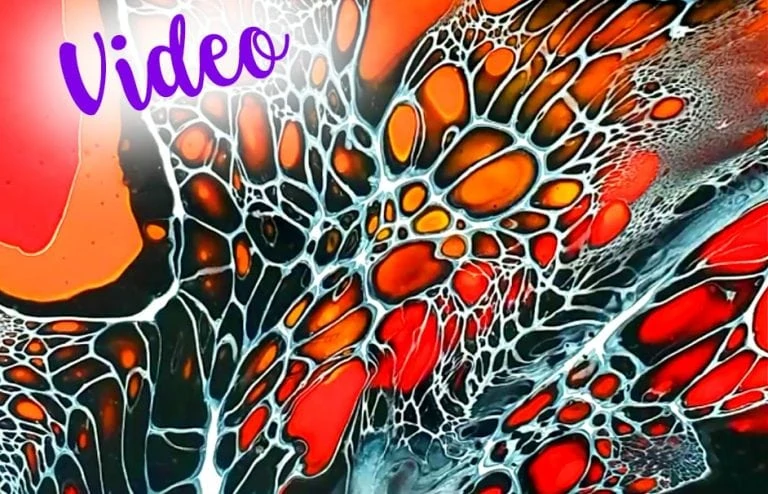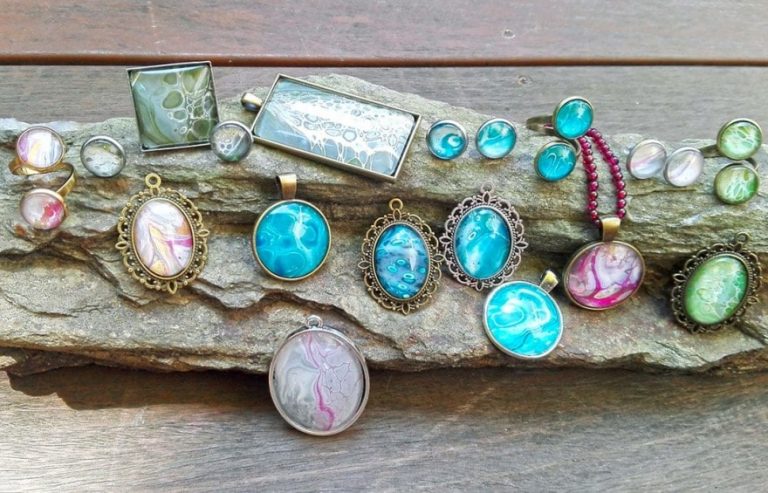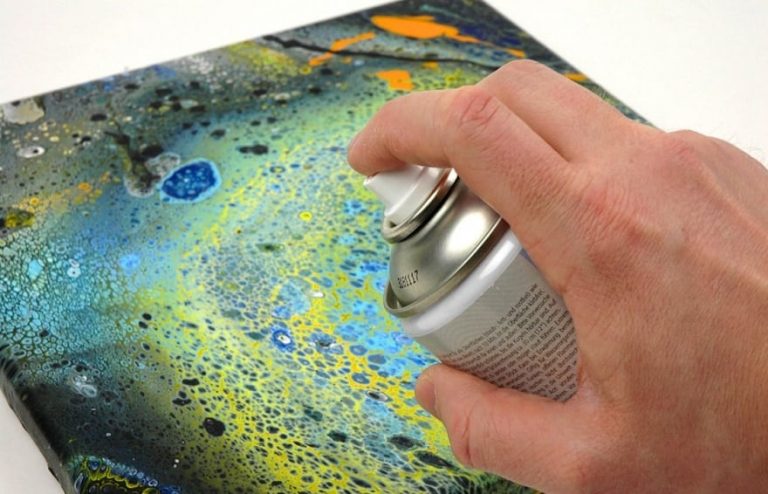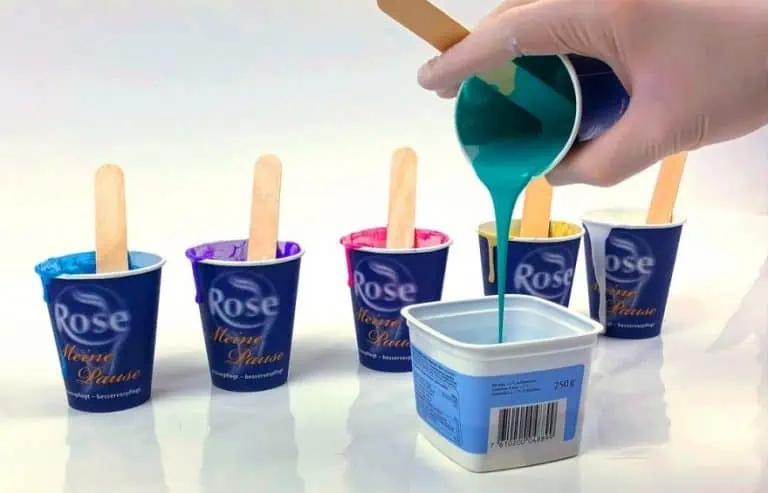Acrylic Pouring Medium: Market Overview and Comparison
This post may contain affiliate links. We may earn a small commission from purchases made through them, at no additional cost to you.
Various types of pouring medium can be used for acrylic pouring. A distinction has to be made between so-called professional and alternative pouring medium, which are not actually intended for acrylic pouring, but also work well and are usually much cheaper. In the following overview, we show you which products there are on the market and what their advantages and disadvantages are.
Table of Contents
- 1 Why you Should use a Pouring Medium for Acrylic Paint Instead of Water
- 2 What is a Professional Pouring Medium
- 3 What is an Alternative Pouring Medium
- 4 Which Mixing Ratio for my Pourings?
- 5 Combination of Different Pouring Media – Recipes
- 6 Fluid Painting with Resin / Epoxy Resin
- 7 The Secret for Cells and what Else you Need to Know
- 8 Frequently Asked Questions about Pouring Medium
Why you Should use a Pouring Medium for Acrylic Paint Instead of Water
Normally you would use water to thin your acrylic paintings. This works very well, doesn’t cost that much, and is very easy. But water dilutes your colors, so it looks washed out. Too much water will also dilute the binding in your acrylic paints, so it doesn’t stick that well on your painting ground / your canvas. Also, the drying isn’t that easy if you use too much water, because this can cause cracks when drying. Once dry, the colors also don’t look as vibrant as if you would use a Pouring Medium for acrylic paint. Using such a medium will give you some benefits: It binds to the paint, the result will be more colorful and you can prevent your pouring from cracking.
If you use a Pouring Medium for acrylic paint, the surface will dry slower and prevent it from cracking by drying too fast. So you have more time to finish your pouring before it’s dry. At the end of this blog article, you’ll find a pouring medium recipe for the right consistency of your pouring mixture.
What is a Professional Pouring Medium
Professional acrylic pouring mediums have been developed specifically for use together with acrylic paints. For obvious reasons, however, the manufacturers do not disclose the ingredients. So what exactly is contained in these products remains a secret. However, you can assume that the durability of your works over the decades is better than with an alternative pouring medium. Nevertheless, you should seal your works with a varnish with UV protection.
In summary, professional pouring medium has the following advantages and disadvantages:
PROS
- Long durability of the acrylic paintings
- Good flow properties
- Fast drying without cracks
- Good colour brilliance even after drying
CONS
- Higher purchase price
Recommendation #1 – Liquitex Pouring Medium
Liquitex has probably one of the highest quality pouring mediums in its range. The Liquitex Professional Pouring Medium is also therefore one of the most frequently used products. At the same time, it is one of the very first pouring medium products, so Liquitex was one of the pioneers in acrylic fluid technology. Once again it becomes clear that Liquitex has many years of experience in the field of artists’ materials. The Liquitex medium always delivers good results, has a perfect consistency and dries up nice and evenly glossy. Especially as a beginner, you will reliably get very nice results with it. For high-quality images, it is therefore worth spending a little more on this medium.
- Liquitex is a high quality and proven pouring medium
- The Liquitex Pouring Medium is easy to use and dries silky shining
- Cells form relatively easily
Recommendation #2 – Pebeo Pouring Medium
Pebeo is a tradition manufacturer for almost all art fields. The Pebeo Pouring Medium delivers reliably, many extraordinary cells of different sizes and types, which is very exciting. This Prouring Medium is really perfect all around and makes every Pourer happy. The consistency is extremely homogeneous, the scent is pleasant and during the drying process the cells remain stable and the colors do not mix. In addition, the cells are very clear and sharply defined with this medium. The surface dries up glossy but not sticky, giving it an extremely high-quality appearance. The medium has a rather thin consistency, which makes it suitable for almost all acrylic paints. Due to all these positive points, the Pouring Medium from Pebeo has clearly earned two “thumbs up” in our test!
- Transparent, glossy and non yellowing
- Optimal in combination with studio acrylics and mat pub colours
- Can be used alone as a brush applied gloss varnish
Recommendation #3 – Solo Goya Pouring Fluid
In our opinion, everything is just right with the Solo Goya Pouring Medium. You achieve many beautiful cells and it has a glossy finish. It is not only one of the best pouring mediums, but at the same time also among the cheapest professional pouring products – so a price-performance ratio which is absolutely unbeatable! A big plus is that this pouring medium is very easy to use and dose. It does not require water, as it already has the perfect consistency. It is not least therefore very well suited for beginners – but at the same time makes every professional Pourer happy because of the 1A quality. Although it is perfectly matched to the Solo Goya Acrylic colors in its application, it can be combined very well with virtually all other color brands. In general, it is very versatile: it can be super mixed with alternative pouring mediums and painting media for individual medium mixtures. The Solo Goya Pouring Fluid is a rather new medium on the market and is considered an absolute insider tip!
- Optimizes the flow behavior of acrylic paints while retaining color brilliance
- Water-based and can be mixed in any ratio with acrylic paint
- Can be used pure as transparent, high-gloss varnish
- Made in Germany
What is an Alternative Pouring Medium
The category alternative Pouring Medium includes all means which have not been explicitly developed for Acrylic Pouring, but which also work very well. You can call them “All-purpose” products. Alternative fluid medium are mostly a little cheaper than professional Pouring medium, but the result hardly differs from the more expensive means. There is currently no knowledge how these alternative acrylic pouring mediums behave over decades. PVA glue, for example, contains a small amount of acid, which could cause the acrylic paints to fade after many years. Also here the sealing of your pictures is important to protect them from UV radiation and environmental influences.
PROS
- Mostly cheaper than professional casting media
- Available in larger containers for frequent users
CONS
- Long-term experiences about the durability of the Acrylic Pouring pictures are still missing
Recommendation #1 from acrylgiessen.com – Floetrol
When it comes to an alternative pouring medium, Floetrol is certainly one of the most commonly used products. Unlike PVA glue, it has a slightly more fluid consistency, which in combination with acrylic paints makes for a very good pouring consistency. So it is very suitable for beginners, but also many experienced pouring artists like to use it. It can also be combined very well with other means and so new recipes can always be developed with it.
- Improves the flow properties of water-based paints
- Very popular alternative casting medium
- Matt finish, perfectly mixable with other casting media
Which Mixing Ratio for my Pourings?
What is the best mixing ratio of acrylic paint and pouring medium? And do you need to add water? These are questions that we can’t answer for you across the board. This is because both the acrylic pouring mediums and the acrylic paints from different manufacturers have different consistencies: Some are thicker, others thinner.
However, we can give you a good starting point as a rule of thumb: start with one part acrylic paint and one part pouring medium. Mix these parts thoroughly and then test the consistency. It should be like slightly thin honey. If the consistency is too thick, you can add more pouring medium and mix again. You can also add some water, but we recommend not to add more than 20% to 30%. Continue this until you reach the desired consistency.
The consistency of your pouring mixture should not be too viscous at all, otherwise cracks can appear when it dries quickly. You should also avoid a mixture that is too thin, as the whole thing will then flow off the painting base and the cells will look so undefined and washed out. So you see, the right consistency is the be-all and end-all of the acrylic flow technique.
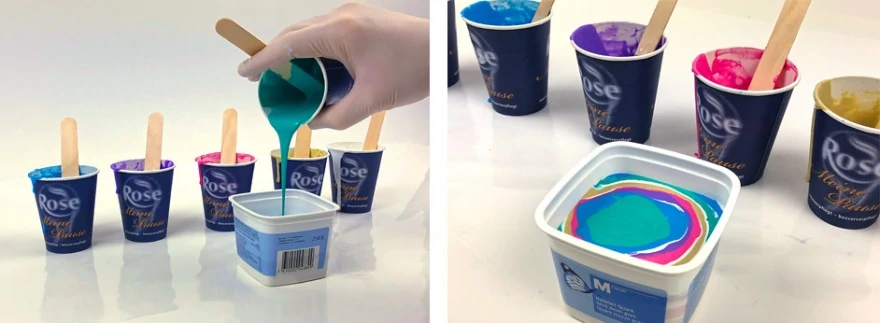
The optimal consistency of your mixture should be thinner than liquid honey.
Combination of Different Pouring Media – Recipes
By the way, you can also mix different casting media – some give a glossy surface, some flow better, others dry matte. If you mix them, you will get some very surprising results. So you can make your own pouring medium. You can also mix Pouring Medium alternatives and professional products. However, mixing more than 2 to 3 products is not necessarily recommended. This will make the result even more unpredictable and you will not know exactly why you achieved the result you did.

Here are some recipes from our Facebook group that have stood the test of time:
| Liquitex |
|
| Liquitex with vinyl adhesive |
|
| Solo Goya with vinyl adhesive |
|
Fluid Painting with Resin / Epoxy Resin
Besides the classic Acrylic Pouring you can also create Fluid Painting paintings with resin / epoxy resin in combination with color pigments or liquid colors. When resin is used, there is no need to finish your pictures, as resin does not require any further protection.
You can find our in-depth tutorial on how to create resin paintings in our article resin art.

The Secret for Cells and what Else you Need to Know
The right acrylic pouring medium is really important for successful acrylic pouring. But really beautiful cells are only created in combination with silicone or hair oil. You can find more about this topic in our article The secret to acrylic pouring cells in your fluid paintings. In another blogpost, we have summarized all other acrylic pouring supplies you need.
Frequently Asked Questions about Pouring Medium
What is a Pouring Medium?
The liquid pouring medium can be mixed with any acrylic paint to create smooth, even color films without increasing the transparency of the paint. It also dries more slowly and without cracking.
Can you make your own Pouring Medium?
Yes, you can make your own pouring medium. Vinyl glue is suitable as a base for this, which is mixed with a little water and at most a few drops of silicone oil.
What is the mixing ratio for the pouring medium?
This varies from product to product. Often the mixing ratio is 1 part ink with 2 parts pouring medium. In addition, a little water is often added to obtain a more fluid consistency.
In 2005, Charlene completed her wellness degrees in therapeutic aromatherapy and reflexology at the International School of Reflexology and Meridian Therapy. She worked for a company offering corporate wellness programs for several years before opening her own therapy practice. In 2015, she was asked by a digital marketer friend to join her company as a content creator, and it was here that she discovered her enthusiasm for writing. Since entering the world of content creation, she has gained a lot of experience over the years writing about various topics such as beauty, health, wellness, travel, crafting, and much more. Due to various circumstances, she had to give up her therapy practice and now works as a freelance writer. Since she is a very creative person and as a balance to writing likes to be active in various areas of art and crafts, the activity at acrylgiessen.com is perfect for her to contribute their knowledge and experience in various creative topics.
Learn more about Charlene Lewis and about us.
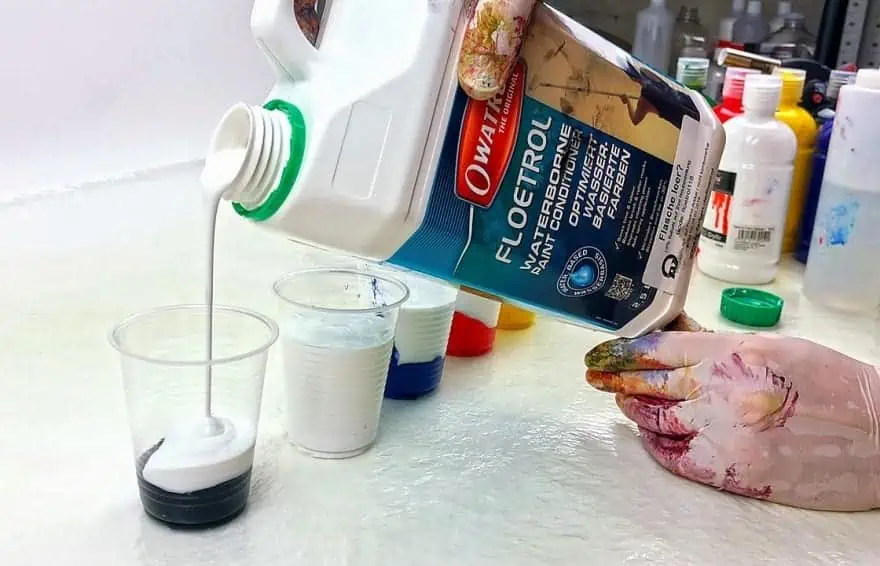






![Acrylic Pouring Guide – Acrylic Pour Painting for Beginners [Tutorial]](https://acrylgiessen.com/wp-content/uploads/2019/01/acrylic-pouring.jpg)
